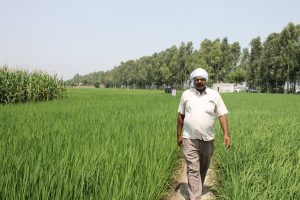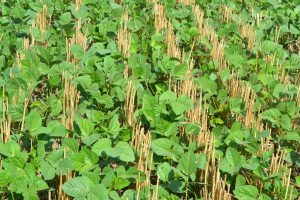
EL BATAN, Mexico (CIMMYT) — Conservation agriculture techniques can help boost yields and profits for smallholder farmers in an intensively cultivated region of India while helping reduce the impact of agriculture on global warming, according to a new research report.
Hardy, high-yielding crop varieties can be resilient to erratic weather patterns caused by climate change, but agricultural intensification must be balanced with sustainable techniques to offset the effects of emissions caused by greenhouse gases.
As part of efforts to achieve agriculture-climate equilibrium, researchers at the International Maize and Wheat Improvement Center (CIMMYT) studied basmati (scented) rice-wheat crop rotation systems in India’s Northwestern Indo-Gangetic Plains, seeking an optimal planting strategy to lower impact on global warming while increasing farm profits.
Overall, they evaluated six different combinations of tillage, residue management and green gram (mung bean) integration into rice-wheat rotations, comparing conventional tillage techniques with conservation agriculture techniques in a village in the northern state of Haryana, known as the basmati rice heartland of India.

“Through research we aimed to identify cropping systems in which greater yields could be achieved at lower production costs leading to higher profitability while minimizing soil and environmental trade-offs,” said M.L. Jat, a systems agronomist based in New Delhi with CIMMYT who worked on the project for more than five years.
“Our study concludes that two ways of managing crop rotation systems: zero tillage rice and zero tillage wheat planted in residue; and zero tillage rice, zero tillage wheat and green gram planted in residue in the rice-wheat systems of this region of India are agronomically productive, economically viable and beneficial for the environment in terms of soil health and greenhouse emissions,” Jat added, referring to the research paper in “Sustainability Journal” titled “Reducing Global Warming Potential through Sustainable Intensification of Basmati Rice-Wheat Systems in India.”
Specifically, scientists examined the best way to sustainably intensify crop production rotation systems to limit greenhouse gas emissions from soil, which include methane, nitrous oxide and carbon dioxide, while adding a third crop to the rotation.
Scientists wanted to help increase production by making use of a normally fallow season from May to July, which marks a pause between growing rice (July to November) and wheat (November to April). Rather than extending the rice and wheat growing seasons, to keep the soil healthy in such a continuous cereal-cereal rotation, they added green gram (mung beans).
By planting basmati rice using a direct seeding method instead of the conventional tillage (puddling) and transplanted method, methane emissions can be reduced by as much as 50 percent, scientists learned. However, reducing methane emissions in a conservation agriculture rice-wheat system is counterbalanced by increased nitrous oxide emissions. Their research concluded that by combining zero tillage and residue retention in the crop growing system, carbon is sequestered in the soil, helping to prevent greenhouse gas emissions.
“Given the dynamics and interdependence of the three greenhouse gases under different management systems, it’s important that all three are measured to determine overall global warming potential of the production system to quantify the mitigation co-benefits of conservation agriculture-based sustainable intensification in basmati rice-wheat systems,” Jat said.
Sowing seeds without tilling or removing residue from the fields contrasted with general practice in the region where farmers typically use conventional agriculture techniques by tilling the soil and removing crop residue from field surfaces before planting.
Scientists determined that using zero tillage with residue retention techniques resulted in the lowest global warming potential. The percentage of Greenhouse gases (CO2-equivalent) released into the atmosphere (on a life cycle analysis basis that includes global warming potential from inputs, operations, emissions and soil organic carbon) was lower by approximately 8 tonnes per hectare per year.
Additional environmental benefits included improved soil health, eliminating residue burning and more efficient water use in fields planted with rice-wheat rotations where conservation agriculture techniques were used. The water use footprint was reduced by almost 30 percent in comparison with farms using conventional tillage systems.
Agriculture and climate change pose complex challenges for scientists trying to improve crop yields on smallholder farms in developing countries. Sustainable intensification based on conservation agriculture principles, including minimal soil disturbance, permanent soil cover, economical and diversified crop rotations, is an important strategy to combat the negative impact of agriculture on the climate and other natural resources while improving the income of smallholder farmers.
Agriculture is the second biggest emitter of greenhouse gases after the energy sector. About 65 percent of farm-related emissions come from methane caused by cattle belching and soil treated with natural or synthetic nitrogen fertilizers, according to the World Resources Institute.
International development targets established by the U.N. climate change agreement aim to curb warming by keeping global temperature increases well below 2 degrees Celsius above pre-industrial levels.
“If sustainable intensification practices are deployed on 26 million hectares of rice-wheat rotations in Asia, we have the opportunity to make a significant contribution to reducing global warming potential and mitigating the impact on the environment,” Jat said.
The study was co-funded by the CGIAR Research Program on Climate Change (CCAFS) and Bayer CropScience.

 Climate adaptation and mitigation
Climate adaptation and mitigation 
